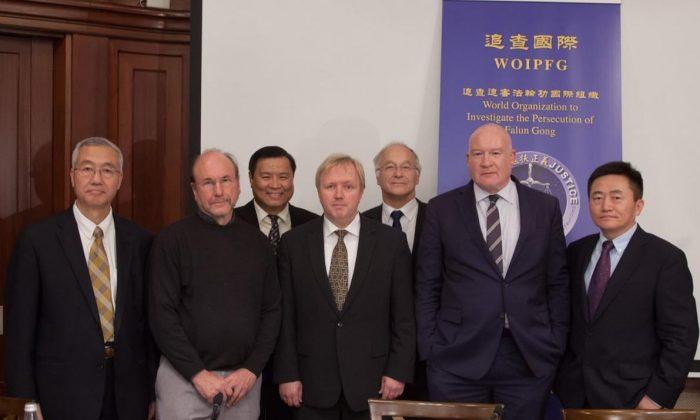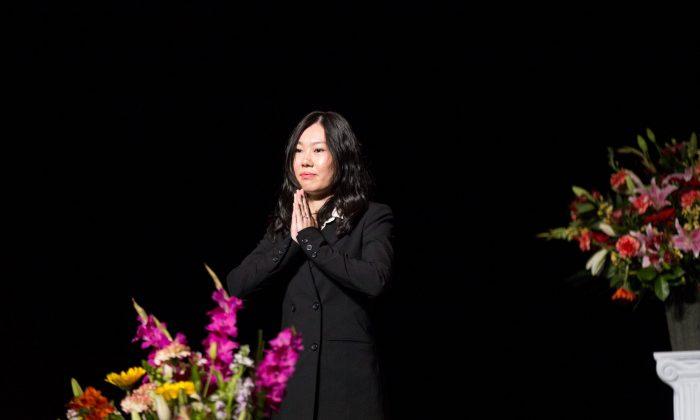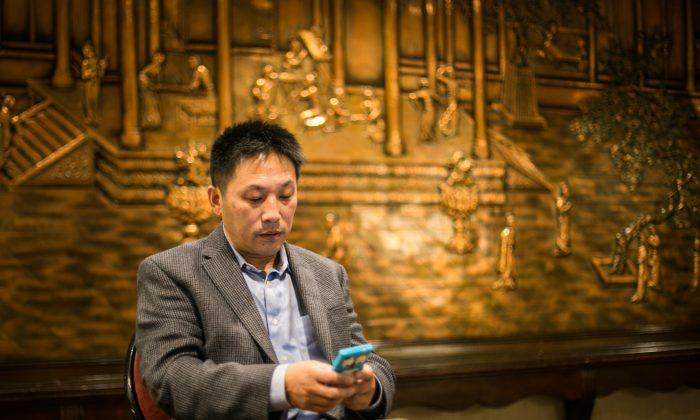TAIPEI, Taiwan—One at a time the students layed their works out before Teacher Tu, waiting for what he would say. “Your ‘le’ [a Chinese character] is too spread out, the top and bottom don’t harmonise. This one’s better,” he said, pointing to the character below le, with a long, rolled up paper, “but still not that good... Be careful now, you’ve made this mistake many times, and I’ve reminded you a lot already. You'll do better now.” The student, a university professor and decades-long practitioner of Chinese calligraphy, was squatting besides his works, nodding at his teacher’s remarks. He rolled up his works and scrambled out of the way for the next person.
“Writing calligraphy,” Tu said, sighing, “you have to cultivate your heart. Only this way will what you write match with what you have inside.” He looked at the students one by one: “You simply must have this kind of internal determination.”
Tu Chungkao is one of Taiwan’s most celebrated calligraphers, having been awarded the prestigious Wu Sanlian and Zhongshan prizes in 1982. He started calligraphy at around 20, after a brief foray into Chinese painting. As a painter, whenever it came to writing his name at the end of the piece, Tu always thought his looked terrible. Before long he decided he would focus on calligraphy for a while, to get to a respectable standard. He has been writing since, and for decades been holding exhibitions around Taiwan, while his works are sold across the world.
The distinguished group of teachers had all come to Tu’s apartment for a one in three month meeting. There, they would receive advice and schooling from the master, and engage in a discussion in one or another obscure aspect of calligraphy. Numbering 13, with only one female, they were mostly professors or artists from around Taiwan. For example, a professor of art theory, a professor of history, and the leading calligrapher at Taiwan’s prestigious National Palace Museum. They have all been students of Tu for decades.
“Writing calligraphy,” Tu said, sighing, “you have to cultivate your heart. Only this way will what you write match with what you have inside.” He looked at the students one by one: “You simply must have this kind of internal determination.”
Tu Chungkao is one of Taiwan’s most celebrated calligraphers, having been awarded the prestigious Wu Sanlian and Zhongshan prizes in 1982. He started calligraphy at around 20, after a brief foray into Chinese painting. As a painter, whenever it came to writing his name at the end of the piece, Tu always thought his looked terrible. Before long he decided he would focus on calligraphy for a while, to get to a respectable standard. He has been writing since, and for decades been holding exhibitions around Taiwan, while his works are sold across the world.
The distinguished group of teachers had all come to Tu’s apartment for a one in three month meeting. There, they would receive advice and schooling from the master, and engage in a discussion in one or another obscure aspect of calligraphy. Numbering 13, with only one female, they were mostly professors or artists from around Taiwan. For example, a professor of art theory, a professor of history, and the leading calligrapher at Taiwan’s prestigious National Palace Museum. They have all been students of Tu for decades.
In 1985, Tu thought he would pick the most “vigorous” of his students to form the group, and they have been gathering four times a year since. Once every few years they put on an exhibition of their works, and have done so five or six times now. Before I was allowed to attend the meeting I was required to visit one of Tu’s current calligraphy exhibitions, featured in local media, to get a flavour for the kinds of things they would be talking about.
The presentation that day was “An investigation into the Phenomenon of Calligraphy Turning into a Form of Contemporary Art,” delivered by Huang Chihyang. He had given it before, apparently to an academic crowd, and spoke to the assemblage from behind his laptop for about two hours. All the lights were off, and the row of windows along one side cast film-noirish shadows across the room. Two porcelain bowls of washed, small tomatoes were set out, and each participant had a small paper cup of tea. Someone passed out copies of two huge, hardback volumes of ancient calligraphy reference texts, showing page after page of tables of the different versions and transformations of the characters, from their ancient forms to today. The paper was thin. At times during the presentation, participants would flip through the books and study some of the symbols intensively; Mr Lin, the lecturer of art theory, would furrow his brow in concentration, quickly drawing Chinese in the air next to the book with his index finger.
While the men and woman in the room stood representing some of the most important figures in the contemporary calligraphy scene in modern Taiwan, they are not the only ones. Like Teacher Tu, other famous teachers also have their own meetings; each of the calligraphy teachers also attend other meetings. Some meetings may have hundreds of participants, while others are less formal than that of Tu’s. Each of Tu’s students, in turn, also has their own group of students. If the teacher is good, they can make a living from it.
Methods for developing the calligrapher’s skills include those described above, where the teacher looks at the student’s work and offers feedback. On other occasions, the teacher will demonstrate directly, with brush and paper, in front of one or a group of students. A fundamental principle of the discipline is perseverance. Students are expected to copy thousands of pages, attempting to emulate the models of Chinese calligraphy from ancient times, like Wang Xizhi, Yan Zhenqing and others. Legend has it that the former blackened the pond outside his home washing his brush in it so many times.
There are also a series of scripts that one can specialise in. They are sufficiently different from one another in form and style that being able to write one impeccably by no means assures being able to write another. They were invented over the long ages of China’s development.
These days in Taiwan, calligraphy is no longer much taught in the schools, if at all. Years ago there were compulsory classes, and years before that, all anyone had to write with was the brush. Now, some Taiwanese may grow up without even picking one up. Those who want to learn need to seek out teachers, pay tuition, and walk the long and slow path of arduous practice. Despite this, it still has a following. Most universities will usually have a calligraphy student club and find a local teacher to guide them, not dissimilar to Tu and his grown up students.
While all Chinese learn how to write characters growing up, exposure to calligraphy at a young age is highly valued. Those who only write with pen and pencil face obstacles when taking up the brush in their middle age.
One by one, they still come to learn though. Calligraphy is a common avocation among retired schoolteachers, a clerk at a calligraphy store explained to me. Some teachers who are not retired but also write might encourage students to practice their calligraphy, too, for example, by bringing in a school group to a store and helping them buy supplies. There are still hundreds and hundreds of the quiet stores filled with paper, books, ink, brushes and other paraphernalia in Taipei.
***
Incense and the soft chanting of Buddhist scriptures from the CD player gently wafted around the apartment; Tu was sitting at his desk, clad in Tang Dynasty-style clothes, quietly practicing Yü Yujen’s calligraphy on a long, thin sheet of paper. I sat down and waited until he finished. He put his brush down, looked at me squarely in the eyes, and said: “Chinese calligraphy is the flower of Chinese civilisation. It is the flower that has grown from the soil of China.”
Later during our chat he drew three circles with a line above them, quickly scrawling the symbols for Buddhism, Confucianism, and Taoism inside. They were the soil of Chinese culture, he explained. Then he drew a flower sprouting out, its roots extending down into the three teachings. The flower was calligraphy, he said, and the three teachings its earth, and the cornerstones of Chinese civilisation.
He also spoke about modern art, and the influence of the west on Chinese civilisation and calligraphy. Despite the inherent conflict in bending the ancient calligraphy brush to contemporary art forms, it has been done. It wasn’t until the 50s, he says, that the influence of modern art started to be felt. After then it has been very much a case of the East copying the West, and the ancient brush being adapted to contemporary forms, however much this has been resisted.
Modern works form the basis of the majority of exhibitions and collections now, and fetch the highest prices at auctions. At the academies though, the traditional style is still favoured, and among the masses that study calligraphy it is still the traditional which is sought after. Mr Lin commented that modern artists all need to have some foundation in the classic styles, too, or they will have a hard time being acknowledged.
All the teachers were fairly unanimous on the state of calligraphy in Taiwan today. It is much less widely practiced than it was, there is less initiative to get the younger generation interested, and it has been more or less left out of the mainstream. Many don’t think it’s necessary, or important. Why? I asked Tu: “Because of computers. The ‘on’ or ‘off’ of a computer has replaced the ‘little on’, ‘a little bit more on’, ‘a lot on’, of the brush pen,” he said, drawing fat, thin, wavy, straight, and multifarious other strokes on a scrap of paper to drive home his point.
I asked what is going to happen in the future, given the current state of affairs. He sat opposite me at the table, and was just then fiddling with an incense stick, trying to shove it into a small, metal holder, but stopped and looked up instantly. “Don’t worry!” he said, his eyes lighting up, “As long as there are the Chinese characters, there will definitely be people writing them!”











Friends Read Free